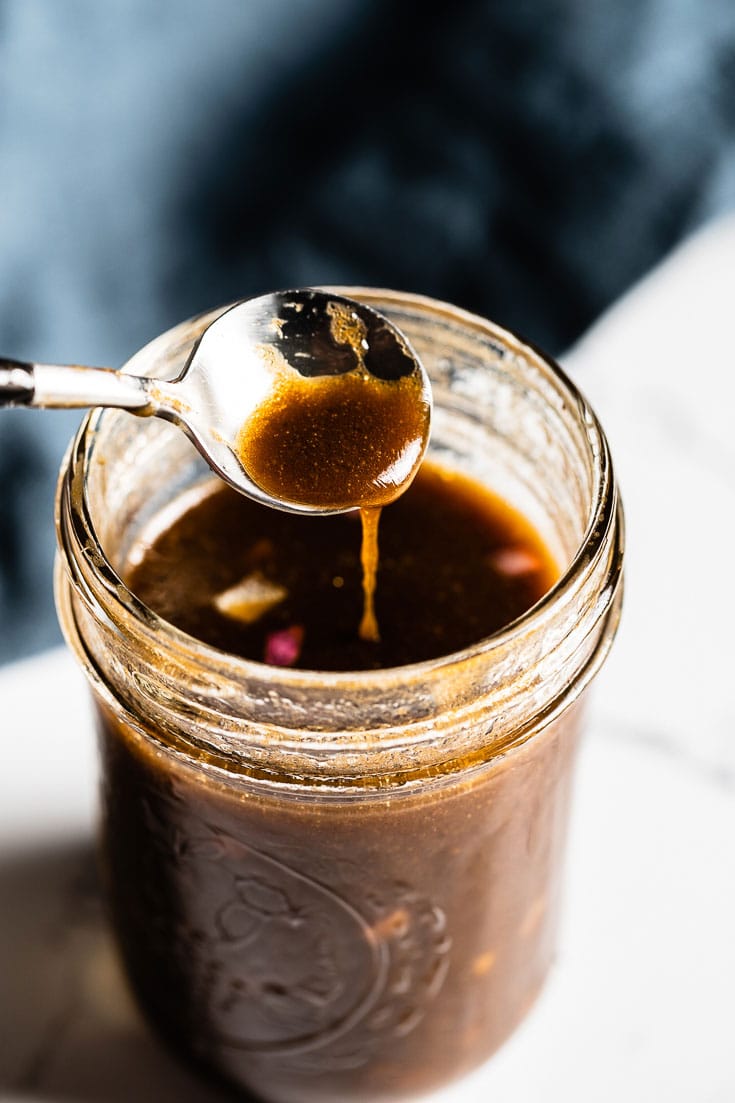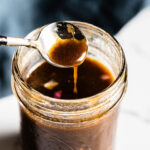Learning to make your own vinaigrette salad dressing can seriously be life-changing. Not only to eat healthier by knowing what you put in your body, but you will be eating more salads and veggies because they just taste better with the added flavor.
Making a vinaigrette is a way to get the whole family involved. It gets them in the kitchen making something that is both tasty and important to the meal. And they get to influence how the vinaigrette will taste by how they adjust the ingredients.
If you are looking to add flavor and brightness to almost any dish, a balsamic vinaigrette is a great way to do it. A good balsamic vinegar has complex sweet and fruity flavors, but with earthy and woody notes from barrel aging, similar in a way to a fine red wine.
A Vinaigrette for Weekly Meal Prep
As easy as making this vinaigrette is; make a larger batch will save you time and have you eating healthy the entire week. You can buy various salad ingredients and vegetables at the beginning of the week and use the same simple balsamic vinaigrette with all the variations.
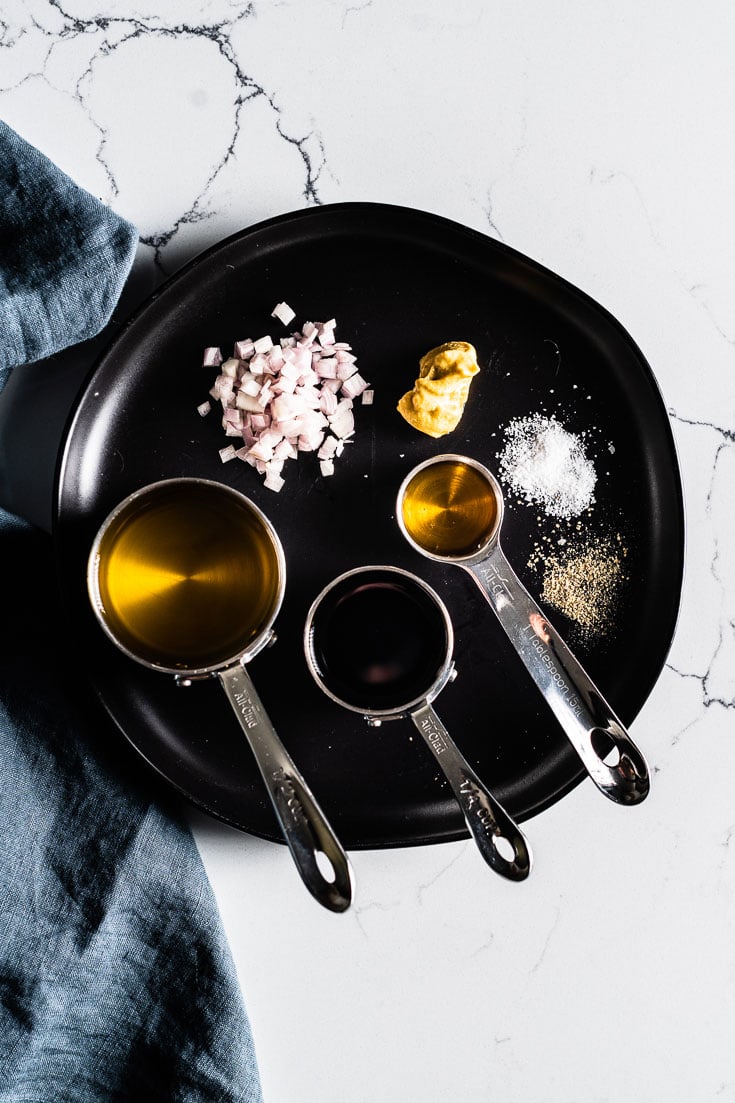
Ingredients You’ll Need
- Good Quality Balsamic Vinegar – Balsamic vinegar has a unique and traditional flavor profile, but don’t be shy about trying flavored balsamic vinegar variations — like fig or basil. Taste the balsamic before you use it. Some are sweeter than others and will need less sweetener to balance out the recipe.
- Good Quality Extra Virgin Olive Oil – Taste the olive oil. Since it is the base and largest-volume of the ingredients that go into the vinaigrette, it has a big influence on the overall flavor. A good olive oil has complex flavors and a peppery bitterness. But if it’s too sharp, it can detract from the vinaigrette. If it tastes like nothing, it will add no flavor. A lack of flavor is also a sign that the olive oil is past its prime, as is a nutty smell or greasy texture.
- Shallot – The shallots add depth and flavor plus a little kick.
- Honey or Sugar – The sweetener balances the acids and oils.
- Dijon Mustard – The mustard adds a rich flavor and creamy texture. It also helps emulsify the oil and vinegar together.
- Optional – You can add minced garlic or fresh herbs to the vinaigrette to change up the flavor even more.
Different Types of Balsamics
Not all balsamics are created equal. There are deeply traditional, certified styles from specific regions in Italy that cost over $100 for a tiny bottle, and there are mass-produced options that use additives to mimic the flavors, color, and texture of the real thing. While you don’t necessarily want to use a the highest-quality artisanal balsamic for a vinaigrette, you want to use one that respects the centuries-old taste and customs of the real thing.
- Traditional Balsamic – Traditional balsamic vinegars are made from crushed grapes and aged a minimum of 12 years in a series of casks made from different woods. Like true Champagne can only be from that region in France, these specialty items can only be from Modena or Reggio Emilia (though artisans in many places mimic the process). Needless to say, they are expensive and unnecessary for a vinaigrette.
- Balsamic Vinegar of Modena – This is the type of balsamic vinegar used in most recipes, and is a derivative of the traditional type. As with many things, generally the higher the price, the higher the quality. The fanciest will be from Modena and have a “PGI” certification, and are aged at least two months. But many wine-making regions, like Sonoma in the U.S., produce high-quality versions using the customary mixture of traditional balsamic, wine vinegar, grape “must”, and caramel. The most important quality in a balsamic vinegar is finding a taste you like, regardless of price or how it’s made.
- White Balsamic – This is a variety created at lower temperatures, so the sugars don’t caramelize. White balsamic has a less complex flavor, and won’t give a dark color to your recipes.
- Flavored or Infused Balsamics – While balsamic vinegar is sweeter and richer than wine or cider vinegar, infusing fruit or other flavors (like ginger) takes it to another level. They come in many varieties, so experiment!
How to Make Balsamic Vinaigrette
There are three easy ways to make a vinaigrette (which is basically just combining all the ingredients). There is the jar shake method, the bowl and whisk method and the blender method. All of these methods work great, but the jar shake method has the advantage of making fewer dishes to clean and it can be stored in the same container it is made in.
With all the methods, it’s important to taste test after the ingredients are combined. If it’s too acidic, add some more honey or sugar.
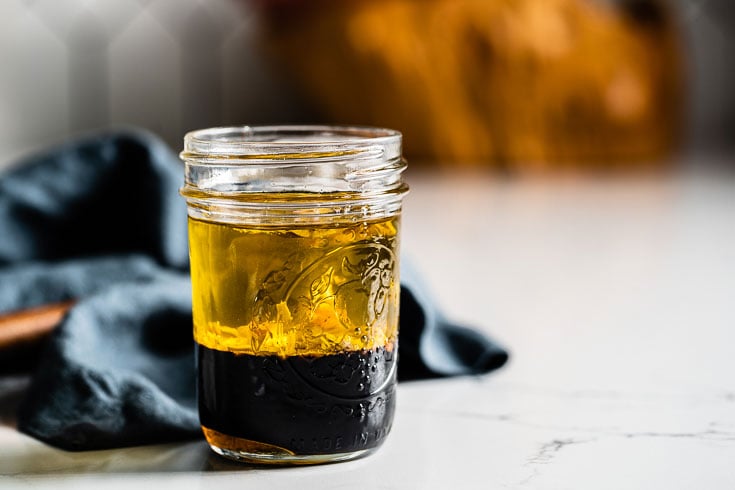
Jar Shake Method
It’s as easy as that; just combine the ingredients in a container and shake them up for about 15 to 30 seconds until everything is combined and the honey is dissolved. If the oil and vinegar start to separate after sitting for a while, just shake it again.
Bowl & Whisk Method
Add all the ingredients to the bowl except for the olive oil and whisk to combine. When you are about ready to use the vinaigrette, slowly drizzle in the olive oil while whisking to create an emulsion.
Blender Method
Add all the ingredients to a blender or immersion blender and blend it up.
Is Balsamic Vinaigrette Healthy?
The word “balsamic” comes from the Italian balsamico, meaning curative or restorative. There are many, many (often unsubstantiated) claims about the positive health effects of balsamic vinegar. But balsamic vinegar is basically a very healthy food, and when combined with extra virgin olive oil and the other ingredients, makes a healthy choice.
When you make the dressing it at home, you know what goes into it unlike the storebought version that you don’t even want to read the label of.
Balsamic Vinaigrette Calories and Nutrition
The nutritional profile of the vinaigrette will depend on the specific type of balsamic vinegar you use, and on the particular mixture of ingredients. But one tbsp of this recipe will have about 100 calories (mostly from the olive oil), roughly 2g of carbs, and about 40mg of sodium.
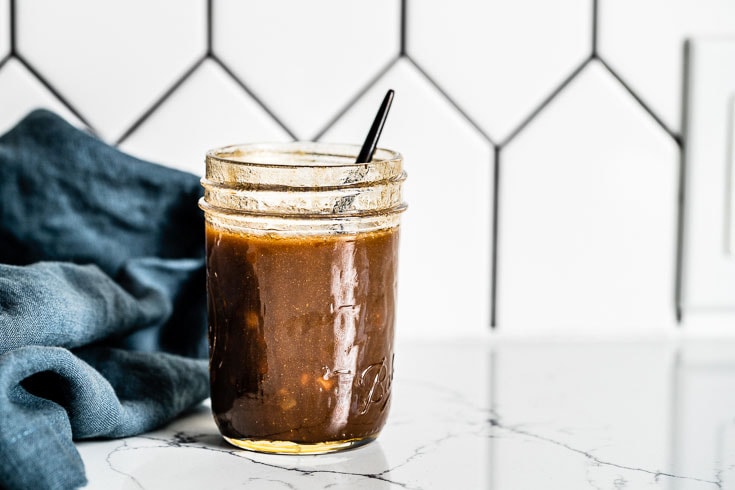
Tools & Equipment
How to Store a Vinaigrette
Since there are shallots and mustard in this vinaigrette, it’s best to store it in the refrigerator. It should last for several weeks, but just use it and make more. Be sure to remove it from the fridge with plenty of time for it to get to room temperature before serving.
These little mason jars are great (pictured below). The reusable lids don’t leak and are perfect for storing. Always add a label with the date so you know how long it’s been in the fridge.
More Vinaigrette Recipes
- Guide to making a basic vinaigrette
- Lemon Vinaigrette
- Apple cider Vinaigrette
- Citrus Vinaigrette
- Sherry Vinaigrette
- Tomato Vinaigrette
- Miso Vinaigrette
How to Use Balsamic Vinaigrette
Using it in a salad tossed with your favorite greens is the obvious choice for using the dressing. Spinach is one of my favorite lettuce pairings, but mixed spring greens are wonderful too. A BLT Salad combines arugula, crunchy bacon and tomatoes for that familiar BLT treat.
Balsamic vinaigrette chicken is such an awesome way to make roasted whole chicken or grilled chicken thighs for a weeknight meal. Place the chicken in a plastic bag and combine with vinaigrette to fully coat the chicken. Seal and refrigerate overnight or at least four hours, then roast or grill just like you would. The flavor you get out of the chicken will be amazing.
The vinaigrette can just as easily be used as a sauce. Drizzle a little on top of a grilled steak, pork tenderloin or even seared duck breasts. Or even use as a dip for your favorite crusty bread.
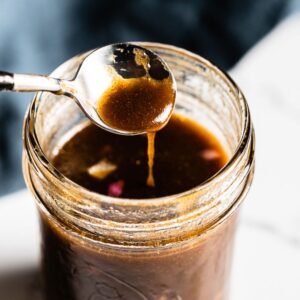
Balsamic Vinaigrette
Ingredients
- 1/4 cup Good Quality Balsamic Vinegar
- 1 tbsp Finely Minced Shallot
- 1 to 2 tbsp Honey or Sugar (depending on the sweetness of your balsamic)
- 1 tsp Dijon Mustard
- 1/4 tsp Kosher Salt
- 1/8 tsp Freshly Ground Black Pepper
- 1/2 cup Extra-Virgin Olive Oil
Instructions
The Jar Shake Method
- Simply add all ingredients to a jar with a tight-fitting lid and shake for about 30 seconds or until the dressing is fully emulsified and the honey is dissolved.
Bowl & Whisk Method
- Add all ingredients except for the oil to a bowl and whisk to combine.
- While continually whisking; slowly drizzle the olive oil into the bowl to emulsify the vinaigrette.
- Taste test for acidity, sweetness and salt, and adjust as needed.
Notes
- Makes about 3/4 cup. The recipe can easily be scaled up or down.
- Shake and make sure all honey is dissolved.
- Taste taste taste, adjust, repeat.
- Store in the refrigerator and bring to room temperature to allow the oil to liquify before serving.

